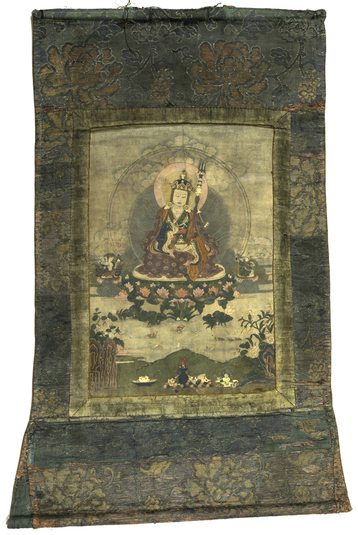
Item: Padmasambhava - (Main Form)
| Origin Location | Tibet |
|---|---|
| Date Range | 1700 - 1799 |
| Lineages | Nyingma, Drukpa (Kagyu) and Buddhist |
| Material | Ground Mineral Pigment on Cotton |
| Collection | Private |
Padmasambhava (Tibetan: pe ma jung ne. English: Lotus Born): also known as Guru Rinpoche (Precious Teacher).
With a steady composure gazing on all beings, one face, without the usual mustache and goatee, the right hand holds to the heart an upright gold vajra (partially effaced). The left hand placed in the lap holds a white skullcup filled with nectar, and a long-life vase. The ornate katvanga staff of a Vajrayana mendicant decorated with streamers rests against the left shoulder. Adorned with gold earrings, the head is covered with a lotus hat, a gift of the King of Zahor, of silk brocade topped with a half-vajra and a single vulture feather. Attired in various robes of different colours reflecting the disciplines of the Vinaya, Bodhisattva and Mantra Vehicles, he sits atop a sun and moon disc above a multi-coloured lotus blossom rising from the calm waters of Dhanakosha lake; encircled by a halo and rainbow sphere. Seated to the viewer's left is the consort Mandarava holding the long-life symbols of an arrow with a mirror and streamers in the right hand and a vase in the left. At the viewer's right is the consort Yeshe Tsogyal holding up a skull offering bowl and a wish-fulfilling jewel.
 Pemasambhava
Pemasambhava  Pema Jungne
Pema Jungne  Biographical Information [TBRC]
Biographical Information [TBRC]
Inscription & Translation:
ཚེ་འོད་སྣང་བ་མཐའ་ཡས་སྒྱུ་འཕྲུལ་གར།
མཚོ་སྐྱེས་རྡོ་རྗེ་སངས་རྒྱས་ཡོངས་ཀྱི་གཙོ།
དེང་འདིར་དབྱེར་མེད་བརྟན་པར་བཞུགས།
འཕོ་མེད་བདེ་བ་ཆེན་པོའི་དངོས་གྲུབ་སྩོལ།
ཅེས་པའང་རང་ཡུལ་སྲིད་སྐྱོང་ཆེན་པོའི་ཐུགས་བཞེད་ལྟར་བདེ་ཆོས་ཡོངས་འཛིན་པས་བྲིས་ཏེ་ཕུལ་བ་དགེའོ
"Om A Hum Vajra Guru Padma Siddhi Hum! Displaying the magical form of Life and Light Amitabha, Padmavajra, Lord of Buddhas, At this very moment remain inseparable forever, And bestow the attainment of unchanging great bliss. (According to the aspiration of our regent, thus it is written and offered by Dechen Chokor Yongdzin (bde chen chos 'khor yongs 'dzin). May it be virtuous!)."
Dechen Chokor Yongdzin is the title of an incarnate line of teachers belonging to the Drugpa Kagyu Tradition of Tibetan Buddhism. The mother monastery is also known as Dechen Chokor. The style of painting for the Padmasambhava composition follows that of Kham and closely with that of Palpung Monastery. The Palpung painting style only came about in the mid 18th century with the tremendous artistic activities of the 8th Tai Situ, Chokyi Jungne (1700-1774 [P956]).
This composition was most likely sponsored by either the 4th Dechen Chokor Yongdzin named Jampal Pawo (1720-1780 [P843]), or the 5th incarnation Yeshe Drubpa (1781-1845 [P618]) a student of the famous 8th Drugchen, Kunzig Chokyi Nangwa (1768-1822 [P846]), a religious teacher and an accomplished artist.
The inscription on the reverse of the painting does not give any obvious clues as to which incarnation is responsible for the work however based on stylistic elements the painting should be dated to the 18th or early 19th century.
Jeff Watt & Karma Gellek 6-2019
Padmasambhava Main Page
Collection: Private 1




